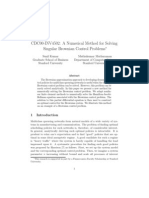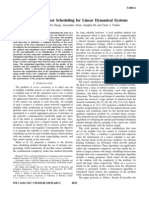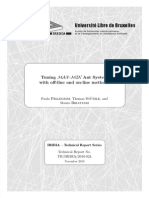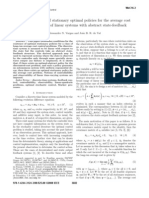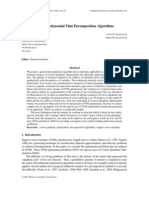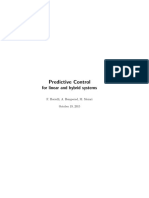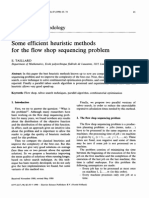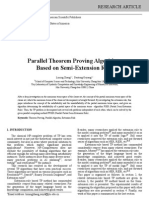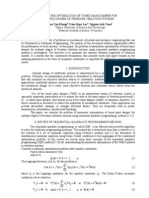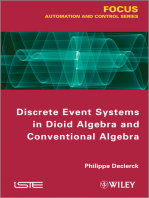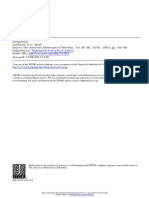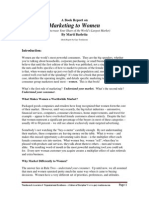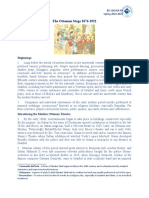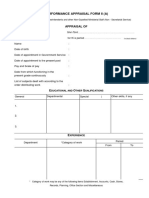Ant Colony Optimization For Optimal Control Problems: Akbar H. Borzabadi and Hamed H. Mehne
Ant Colony Optimization For Optimal Control Problems: Akbar H. Borzabadi and Hamed H. Mehne
Uploaded by
Pasupuleti SivakumarCopyright:
Available Formats
Ant Colony Optimization For Optimal Control Problems: Akbar H. Borzabadi and Hamed H. Mehne
Ant Colony Optimization For Optimal Control Problems: Akbar H. Borzabadi and Hamed H. Mehne
Uploaded by
Pasupuleti SivakumarOriginal Description:
Original Title
Copyright
Available Formats
Share this document
Did you find this document useful?
Is this content inappropriate?
Copyright:
Available Formats
Ant Colony Optimization For Optimal Control Problems: Akbar H. Borzabadi and Hamed H. Mehne
Ant Colony Optimization For Optimal Control Problems: Akbar H. Borzabadi and Hamed H. Mehne
Uploaded by
Pasupuleti SivakumarCopyright:
Available Formats
ISSN 1746-7659, England, UK
Journal of Information and Computing Science
Vol. 4, No. 4, 2009, pp. 259-264
Ant Colony Optimization for Optimal Control Problems
Akbar H. Borzabadi 1, and Hamed H. Mehne 2
1
Dept. of Appl. Math., Damghan Univ. of Basic Sciences, 36715-364, Iran.
Aerospace Research Institute, Tehran, 15875-3885, Iran. E-mail: hashemi@math.um.ac.ir
(Received December 26, 2008, accepted April 17, 2009)
Abstract. Ant algorithm optimization is used to solve a general class of optimal control problems with
single input control. The discretized form of the optimal control problem is converted to a quasi quadratic
assignment problem in the time-control space. By applying the ant optimization algorithm on this problem, a
piece-wise constant approximation is obtained for the optimal control. Implementation of the method and
numerical results are also discussed.
Keywords: Meta-heuristic algorithms, ant colony optimization, optimal control problems.
1. Introduction
In early decades optimal control theory as one of the most applicable and technological issues has been
taken into consideration. The analytical solutions for problems of optimal control are not always available.
Thus to find approximate solution is the most logical way to solve them. To this end, various approaches
such as discretization [14], measure theory [10], polynomial parametrization [9, 8], etc., have been proposed.
Some heuristic algorithms such as genetic algorithms [7] have been also applied to solve optimal control
problems (OCP's). Our aim is to apply Ant Colony Optimization (ACO) method to construct approximate
optimal control function for a general class of OCPs. To implement this method we first discretize the timecontrol space. This control discretization enables us to examine different choices of controls to find the
optimal one in assignment of constant controls to sub-intervals. This assignment nature of the problem
encourages us using a meta heuristic as ACO method to solve the problem. The advantages may be
encounter as the method is self-starting i.e. it doesn't need any approximate solution to be started, and the
type of dynamical system and performance index doesn't have serious effect on the method because it uses
direct evaluations of controls.
Metaheuristics incorporate concepts from very different fields such as genetics, biology, artificial
intelligence, mathematics and physics and neuro-science among others. Examples of methahuristics include
simulated annealing, tabu search, iterated local search, variable neighborhood search algorithms, greedy
randomized adaptive search procedures and evolutionary algorithms.
ACO is currently one of the best available meta-heuristic for some problems and is amongthe most
competitive approaches for discrete optimization problems [1, 4, 6]. The essential framework of the ACO is
search over several constructive computational threads, based on a memory structure incorporating the
information about the effectiveness of previously obtained fragments of solutions. This structure is
maintained dynamically by deposit, evaporation and detection of conceptual pheromone.
Several algorithms have been proposed in the literature following the ACO metaheuristic, (see [3]). The
first ACO algorithm, called Ant System (AS) [6], was initially proposed by Dorigo et al. and then this
algorithm was applied to the well-known traveling salesman problem as a benchmark problem [5]. AS has
been the prototype of many following ACO algorithms with which many other NP-hard combinatorial
optimization problems can be solved successfully. Ant algorithms have also been applied to the Facilities
Layout Problem which can be shown to be a Quadratic Assignment Problem (QAP).
Corresponding author. Tel.: +98-232-5235316; fax: +98-232-5235316.
E-mail address: borzabadi@dubs.ac.ir
Published by World Academic Press, World Academic Union
Akbar H. Borzabadi , et al: Ant Colony Optimization for Optimal Control Problems
260
Fig. 1. A typical control function in time-control discretization
2. Discretized Optimal Control Problem
There are many examples in science and engineering involving optimal control problems.
Mathematically, an OCP's deals with optimizing a performance index having the pair state control satisfying
a dynamical system. There may be also bounding conditions on the state and some restrictions on control.
Different types of the performance index and dynamical systems accompanied with various bounding
conditions lead to a wide variety of definitions for OCPs. Exact and numerical methods for solving OCPs are
highly dependent to the form of the problem. As we are going to develop a numerical method for solving
general OCPs, let consider the minimizing of a performance index like
tf
I ( x(t ), u (t )) f (t , x(t ), u (t ))dt
(1)
where t f 0 is given and f is an integrable function with no restriction about linearity and differentiability.
The state and control satisfy a dynamical system as
x (t ) g (t , x(t ), u (t )), t (0, t f )
(2)
with x(0) x 0 and x(t f ) x f as initial and final given conditions. The single valued control function gives
its values from a known interval [u , u ] .
To find the optimal solution we must examine the performance index in the set of all possibilities of
control-state pairs. This set is called the set of admissible pairs consisting of pairs like ( x, u ) satisfying in (2)
and other mentioned conditions. If we choose a control function u and solve (2) with initial conditions, then
resulting state may not reach to x0 at t t f and a miss distance between x(t f ) and x0 is introduced. Now
if the norm of miss distance is added to the performance index as a penalty, then minimizing
I M x(t f ) x0 forces the control to produce an admissible state. This enables us to reduce the
admissible set of control-states to the admissible set of controls only. So we could search for the optimal
solution in the set of all controls. This process of constructing optimal solutions from control function is a
popular method in optimal control theory which appears in literature under control parametrization [9, 15]
and control discretization [10].
Here we develop a control discretization based method where the time interval is divided to n subinterval [t 0 , t1 ], [t1 , t 2 ], , [t n 1 , t n ] . On the other hand the set of control values is divided to constant values
u1 , u 2 , , u m . In this way the time-control space is discretized if the control function assumes to be constant
at each time sub-interval. A typical dicsretization is given in Fig.1 with n 7 and m 6 . The bold pattern
in this picture shows a control function.
3. Converting OCP to AS
Discretization proposes to consider control function as a sequence of u j segments corresponding to time
JIC email for contribution: editor@jic.org.uk
Journal of Information and Computing Science, Vol. 4 (2009) No. 4, pp 259-264
261
sub-intervals. Now a trivial way to find the nearly optimal solution is to calculate all possible patterns and
compare the corresponding trade offs. This trivial method of total enumeration needs m n evaluation.
Avoiding of such a huge number of computations, we introduce a method of evaluating special patterns
guiding us to the optimal one. The main drawback of the total enumeration is that the method evaluates all of
the control patterns independently i.e. the evaluated performance index of the current pattern doesn't have a
role in construction the next pattern. With AS approach we construct patterns based on the performance
index of pervious iterations leading to a method with computations less than the total enumeration.
For converting the OCP to AS we use a similar framework of solving QAP by ACO. In fact we decide to
assign for every interval [ti 1 , ti ], i 1, 2, , n, , a constant u k u 0 , u1 , , u m .
Special form of our problem suggests us to use another version of ACO, called Max-Min Ant System
(MMAS). This method, the first used to solve TSP ([11, 12]) and then used for solving QAP in [12]. In fact
this method is one of the best performing extensions of AS. It extends the basic AS in the following aspects
which is quoted from [3]:
1. After each tour, updating of trial will be done by an ant, i.e. that ant which obtains the best solution in
currently tour or the best solution from the first tour until current tour. After all ants have constructed a
solution, first every pheromone trial is evaporated:
rs (1 ) rs ,
and next pheromone is deposited according to:
rs rs f (C ( S best )), a rs S best ,
where f (C ( S )) is the amount of pheromone released depends on the quality C (S ) , C (S ) is a cost
associated to each solution S , S best is the best solution and (0,1] is evaporation rate. The best ant that
is allowed to add pheromone may be the iteration-best or the global best solution. Experimental results have
shown that the best performance is obtained by gradually increasing the frequency of choosing the globalbest solution for the pheromone trial update. In addition in MMAS typically the ants solutions are improved
using local optimizers before the pheromone update.
2. Also in MMAS, the value of pheromone is restricted in a closed interval [ min , max ] . The chance of
algorithm stagnation is thus decrease by giving each connection some, although very small, probability of
being chosen. In practice, heuristics exist for setting min and max . First it can be shown that, because of the
*
pheromone evaporation, the maximal possible pheromone trial level is limited to max
1
, where S *
*
.C ( S )
is the optimal solution.
Based on this result, the global best solution can be used to estimate max by replacing S * with
*
S global best t in the equation for max
. For min it is often enough to choose it as some constant factor lower
than max . As a means for further increasing the exploration of solution, MMAS also uses the occasional reinitialization of pheromone trails.
3. Instead of initializing the pheromones to a small amount, in MMAS the pheromone trails are
initialized to an estimate of the maximum allowed pheromone trail value. This leads to an additional
diversification component in the algorithm, because at the beginning the relative difference of the pheromone
trails will not be very marked, which is different when initializing the pheromone trails to some very small
value.
The procedure of MMAS can be found in [11] with more details. Two special properties of this method
are as follows:
i) items are chosen randomly,
ii) pheromone trails refers to the desirability of assigning item i to location j in iteration s is as:
pijk ( s )
ij ( s)
.
il (s)
l
JIC email for subscription: publishing@WAU.org.uk
Akbar H. Borzabadi , et al: Ant Colony Optimization for Optimal Control Problems
262
For using a method which is based on MMAS, we need to define a criteria for measuring the objective
and updating the trials of pheromone. For this purpose, we suppose that after the iteration s we obtain the
control u s as:
n
u s (t ) u s [t 1 ,t ] (t ),
1
where u
is the selection of the th value of control in interval [t 1 , t ] . As it is mentioned in Section 2
we consider an approximation of trajectory x(t ) corresponding to u s (t ) from (2) and initial value, and we
call it x s (t ) . We also denote the estimation of the criteria for updating tour (pattern) in s th iteration by
J s and define it as follows:
tf
J s f (t , x s (t ), u s (t ))dt M x s (t f ) x f
(3)
where M is a large and positive real number which we consider it as a penalty value for obtaining desired
final value f . In fact s is the same C (S ) which is defined in the above. To be taken note that the
definition of criteria estimation can be done in different manners. On basis of the discussion in this section,
we present the following procedure for obtaining an approximate solution of the optimal control problem in
format of MMAS as following pseudo-code:
0.(Initialize) Control-state parametrization, method parameter settings
1. For s 1 to s : the maximum number of iterations, do
2. For k 1 1 to m : the number of ants, do
3. Repeat until ant k has completed a tour
4. Determine the best probability
5. Calculate the objective
pijk
J s of the tour generated by ant k
*
6.Call the best objective between all tours of ants as J and update general pheromone.
Numerical Examples
In this section we present some numerical examples to show the implementation and accuracy
confirmation of the proposed method.
Example 1. In the first example we consider an OCP of minimizing
Fig.2. The resulting piece-wise control of Example 1.
JIC email for contribution: editor@jic.org.uk
Journal of Information and Computing Science, Vol. 4 (2009) No. 4, pp 259-264
263
Fig.3. The resulting state of Example 1.
1
I (u ()) u 2 (t )dt ,
0
subject to
1 2
x sin x u
2
with x(0) 0 , x(1) 0.5 as initial and final conditions. Here the control function values are in [0.3, 0.7] .
For control-state division we choose n 10 and m 10 . By applying the procedure of Section 4 with 100
ants we obtain I * 0.2293 in 50 iterations. The approximate optimal control in piece-wise linear form is
shown in Fig.2. If we substitute this function in the system equations, then an initial valued problem is left to
solve by a numerical method.
We solve this initial value problem by using Rung-Kutta method of forth order ([2]) to find the
corresponding state function as depicted in Fig.3. The value of trajectory corresponding to the final time t f
is x * (1) 0.4968 which shows the accuracy of the method in final condition.
Example 2. In the second example we consider a nonlinear OCP involving minimization of
1
I ( x1 (), x 2 ()) ( x1 (t ) x 2 (t ))dt ,
2
where the pair of control-state satisfy in the following non-linear dynamical system:
x1 x 2 ,
x 2 10 x13 u,
Fig.4. The resulting states of Example 2.
It is desired that the system state moves from (0, 0) at t 0 to (0.1, 0.3) at t 1 . The control value
interval is given by [0, 0.5] which is divided to m 10 portion. The time interval is also divided to
JIC email for subscription: publishing@WAU.org.uk
Akbar H. Borzabadi , et al: Ant Colony Optimization for Optimal Control Problems
264
n 10 sub-intervals. By using 200 ants in this example, the method converges to the solution in only 80
iterations. The _nal value of approximate optimal trajectories are obtained with low miss distances as
x1 (1) 0.1009 and x 2 (1) 0.2969 . The resulting approximate trajectories which have been found by
*
solving the di_erential equation with the resulting control function and initial conditions are depicted in Fig.4.
4. Conclusions
In this paper we tried to apply the benefits of one of the best evolutionary algorithm, ant colony
optimization, to obtain approximate solution of optimal control problems. To this means, we proposed an
special discretization of control state and then change the procedure of MMAS to obtain the best solution.
Numerical results show the accuracy of the method in final conditions. Of course it seems that the number of
iterations, ants and the form of discretizing effect on the complexity of method, but the nonlinearity of the
objective and system have no serious effect on the procedure. In the case of large discrete optimal control
problem, the method may be implemented on parallel computers to save the computational time.
5. References
[1] E. Bonabeau, M. Dorigo, and G. Theraulaz. Inspiration for Optimization from Social Insect Behaviour. Nature.
2000, 406: 39-42.
[2] L. Collatz. The Numerical Treatment of Differential Equations. Berlin: Springer, 1960.
[3] O. Cordon, F. Herrera, and T. Stuzle. A review on the Ant Colony Optimization metaheuristic: basis, models and
new trends. Mathware and Soft Computing. 2002, 9: 135.
[4] M. Dorigo, Optimization. Learning and Natural Algorithms. Ph.D. thesis, Politecnico di Milano, 1992.
[5] M. Dorigo, and L. M. Gambardella. Ant Colonies for the Travelling Salesman Problem. Biosystems. 1997, 43: 7381.
[6] M. Dorigo, V. Maniezzo, and A. Colorni. The Ant System: Optimization by a colony of cooperating agents. IEEE
Transactions on Systems., Man, and Cybernetics - Part B. 1996, 26: 113.
[7] O. S. Fard, and A. H. Borzabadi. Optimal control problem, quasi-assignment problem and genetic algorithm.
Enformatika, Transaction on Engin., Compu. and Tech.. 2007, 19: 422-424.
[8] H. M. Jaddu. Numerical Methods for solving optimal control problems using chebyshev polynomials. PhD thesis,
School of Information Science, Japan Advanced Institute of Science and Technology, 1998.
[9] H. H. Mehne, A. H. Borzabadi. A numerical method for solving optimal control problems using state
parametrization. Numerical Algorithms. 2006, 42(2): 165-169.
[10] J. E. Rubio. Control and Optimization the Linear Treatment of Non-linear Problems. Manchester, U. K.,
Manchester University Press, 1986.
[11] T. Stuzle, and H. H. Hoos. The MAX - MIN Ant System and local search for the traveling salesman problem. In T.
Back, Z. Michalewicz, and X. Yao, editors, Proceedings of the 1997, IEEE International Conference on
Evolutionary Computation (ICEC97).1997, pp. 309-314.
[12] T. Stuzle, and H. H. Hoos. MAX-MIN Ant System. Future Generation Computer Systems Journal. 2000, 16(8):.
889-914.
[13] T. Stuzle. MAX-MIN Ant System for the quadratic assignment problem. Technical Report AIDA974. FG
Intellektik, FB Informatik, TU Darmstadt, July 1997.
[14] K. L Teo, C. J. Goh, and K. H. Wong. A unified computational approach to optimal control problems. Longman
Scientific and Technical, 1991.
[15] K. L Teo, L. S. Jennings, H. W. J. Lee, V. Rehbook. Control parametrization enhancing transform for constrained
optimal control problem. J. Aust. Math. Soc.. 1999, B40: 314-335.
JIC email for contribution: editor@jic.org.uk
You might also like
- Principal Entry PlanDocument5 pagesPrincipal Entry Planapi-324877768No ratings yet
- Book Review - World Religions - A Guide To The Essentials, 2nd EdDocument2 pagesBook Review - World Religions - A Guide To The Essentials, 2nd EdEaglemsian100% (2)
- Wasyl Wasylkiwskyj (Auth.) - Signals and Transforms in Linear Systems Analysis-Springer-Verlag New York (2013) PDFDocument387 pagesWasyl Wasylkiwskyj (Auth.) - Signals and Transforms in Linear Systems Analysis-Springer-Verlag New York (2013) PDFPasupuleti SivakumarNo ratings yet
- MX2 Training Program 10C Wedge Delay Calibration WizardDocument18 pagesMX2 Training Program 10C Wedge Delay Calibration WizardVictor Antonio Diaz Faundez100% (1)
- Chopped Random Basis Quantum Optimization: PACS NumbersDocument10 pagesChopped Random Basis Quantum Optimization: PACS NumbersgomariosNo ratings yet
- Ant Colony Based Load Flow Optimisation Using Matlab: Upamanyu Keshav Bansal, Miteshwar SinghDocument5 pagesAnt Colony Based Load Flow Optimisation Using Matlab: Upamanyu Keshav Bansal, Miteshwar SinghpakivermaNo ratings yet
- Optimal Control of A Hybrid Dynamical System: Two Coupled TanksDocument25 pagesOptimal Control of A Hybrid Dynamical System: Two Coupled TanksPhạm Ngọc HòaNo ratings yet
- Trajectory Survey of Optimization TechniquesDocument32 pagesTrajectory Survey of Optimization TechniquesRajib PalNo ratings yet
- A Real-Time Gradient Method For Nonlinear Model Predictive ControlDocument21 pagesA Real-Time Gradient Method For Nonlinear Model Predictive ControlvuvuvuvNo ratings yet
- Optimal Supervisory Control Synthesis Hassane AllaDocument20 pagesOptimal Supervisory Control Synthesis Hassane AllaAmadouMalickMouamfonMoumbagnaNo ratings yet
- Some Efficient Heuristic Methods For The Flow Shop Sequencing ProblemDocument21 pagesSome Efficient Heuristic Methods For The Flow Shop Sequencing ProblemDeba SahooNo ratings yet
- Analysis and CompensationDocument25 pagesAnalysis and Compensationshaho1946No ratings yet
- Comparative Analysis of Evolutionary Techniques For Relay CoordinationDocument6 pagesComparative Analysis of Evolutionary Techniques For Relay CoordinationMahesh SinghNo ratings yet
- A Comparison of Deterministic and Probabilistic Optimization Algorithms For Nonsmooth Simulation-Based OptimizationDocument11 pagesA Comparison of Deterministic and Probabilistic Optimization Algorithms For Nonsmooth Simulation-Based Optimizationtamann2004No ratings yet
- CDC00-INV4502: A Numerical Method For Solving Singular Brownian Control ProblemsDocument6 pagesCDC00-INV4502: A Numerical Method For Solving Singular Brownian Control ProblemsKumar MuthuramanNo ratings yet
- On Efficient Sensors SchedulingDocument6 pagesOn Efficient Sensors Schedulingأمين سيدNo ratings yet
- Université Libre de Bruxelles: Tuning MAX-MIN Ant System With Off-Line and On-Line MethodsDocument23 pagesUniversité Libre de Bruxelles: Tuning MAX-MIN Ant System With Off-Line and On-Line Methodslcm3766lNo ratings yet
- On The Existence of Stationary Optimal Policies For The Average Cost Control Problem of Linear Systems With Abstract State-FeedbackDocument6 pagesOn The Existence of Stationary Optimal Policies For The Average Cost Control Problem of Linear Systems With Abstract State-Feedbackmjksh62No ratings yet
- Predictive Control: For Linear and Hybrid SystemsDocument458 pagesPredictive Control: For Linear and Hybrid SystemsSanthosh KumarNo ratings yet
- General Polynomial Time Decomposition Algorithms: Nikolas List Hans Ulrich SimonDocument19 pagesGeneral Polynomial Time Decomposition Algorithms: Nikolas List Hans Ulrich SimonAnkita SomanNo ratings yet
- Designing Controller by State Space Techniques Using Reduced Order Model AlgorithmDocument5 pagesDesigning Controller by State Space Techniques Using Reduced Order Model AlgorithmGladiolus TranNo ratings yet
- The Application of Command Generator Tracker Concept in Model Reference Adaptive Control of Chemical ProcessesDocument10 pagesThe Application of Command Generator Tracker Concept in Model Reference Adaptive Control of Chemical ProcessesHasna LabibahNo ratings yet
- Linear-Quadratic Optimal Control With Integral Quadratic ConstraintsDocument14 pagesLinear-Quadratic Optimal Control With Integral Quadratic ConstraintsbenlamNo ratings yet
- Borelli Predictive Control PDFDocument424 pagesBorelli Predictive Control PDFcharlesNo ratings yet
- Adaptive Model Predictive Control For A Class of Constrained Linear Systems Based On The Comparison ModelDocument8 pagesAdaptive Model Predictive Control For A Class of Constrained Linear Systems Based On The Comparison Modelshiva shakthyNo ratings yet
- Title of The Paper (Use Title Style) : Original Article Original Article Original ArticleDocument5 pagesTitle of The Paper (Use Title Style) : Original Article Original Article Original ArticleMuhammad Mushlih ElhafidNo ratings yet
- ShimuraDocument18 pagesShimuraDamodharan ChandranNo ratings yet
- Model Predictive ControlDocument460 pagesModel Predictive ControlHarisCausevicNo ratings yet
- The Optimal Design and Simulation of Helical Spring Based On Particle Swarm Algorithm and MatlabDocument10 pagesThe Optimal Design and Simulation of Helical Spring Based On Particle Swarm Algorithm and MatlabvenkiteshksNo ratings yet
- MPC BookDocument464 pagesMPC BookNilay Saraf100% (1)
- RL Unit 3,4,5Document19 pagesRL Unit 3,4,5Shrishti BhasinNo ratings yet
- Some Efficient Heuristic Methods For The Flow Shop Sequencing ProblemDocument10 pagesSome Efficient Heuristic Methods For The Flow Shop Sequencing Problemjsofv5533No ratings yet
- Parallel Theorem Proving Algorithm Based On Semi-Extension RuleDocument4 pagesParallel Theorem Proving Algorithm Based On Semi-Extension RuleM Naveed AkramNo ratings yet
- 1 s2.0 S1474667016440140 MainDocument6 pages1 s2.0 S1474667016440140 Mainduy0378578911No ratings yet
- The Application of Command Generator Tracker Concept in Model Reference Adaptive Control of Chemical ProcessesDocument9 pagesThe Application of Command Generator Tracker Concept in Model Reference Adaptive Control of Chemical ProcessesHasna LabibahNo ratings yet
- ZzzChapter 3 - Section 3.3.8Document11 pagesZzzChapter 3 - Section 3.3.8Buddhi ChinthakaNo ratings yet
- MPC Yalmip MPTDocument6 pagesMPC Yalmip MPTJules JoeNo ratings yet
- FVEG For Hyperbolic SystemsDocument29 pagesFVEG For Hyperbolic SystemsAnand MaltoNo ratings yet
- BBMbook Cambridge NewstyleDocument373 pagesBBMbook Cambridge Newstylejpvieira66No ratings yet
- Model-Based Adaptive Critic Designs: Editor's SummaryDocument31 pagesModel-Based Adaptive Critic Designs: Editor's SummaryioncopaeNo ratings yet
- Special Study ReportDocument16 pagesSpecial Study ReportDuc Huan TranNo ratings yet
- Observer Hybrid Systems 4Document12 pagesObserver Hybrid Systems 4Paulina MarquezNo ratings yet
- Linear Estimation For Random Delay SystemsDocument10 pagesLinear Estimation For Random Delay SystemsPraneeth BobbaNo ratings yet
- Hone On Nonstandard Numerical Integration Methods For Biological OscillatorsDocument17 pagesHone On Nonstandard Numerical Integration Methods For Biological Oscillatorsjjj_ddd_pierreNo ratings yet
- RevisedDocument6 pagesRevisedPaulina MarquezNo ratings yet
- Solving The Traveling Salesman Problem With Ant Colony Optimization: A Revisit and New Efficient AlgorithmsDocument9 pagesSolving The Traveling Salesman Problem With Ant Colony Optimization: A Revisit and New Efficient AlgorithmsViet DinhvanNo ratings yet
- A Transient Manufactured Solution For The Compressible Navier-Stokes Equations With A Power Law ViscosityDocument16 pagesA Transient Manufactured Solution For The Compressible Navier-Stokes Equations With A Power Law ViscosityRhysUNo ratings yet
- On The Rate of Convergence For The Pseudospectral Optimal Control of Feedback Linearizable SystemsDocument28 pagesOn The Rate of Convergence For The Pseudospectral Optimal Control of Feedback Linearizable SystemssssdaitNo ratings yet
- (IJCST-V9I5P4) :monica Veronica Crankson, Olusegun Olotu, Newton AmegbeyDocument9 pages(IJCST-V9I5P4) :monica Veronica Crankson, Olusegun Olotu, Newton AmegbeyEighthSenseGroupNo ratings yet
- Adpt PP CSTR MatlabDocument8 pagesAdpt PP CSTR MatlabRuchit PathakNo ratings yet
- Parameter Optimization of Tuned Mass Damper - Nguyen Van Khang, Nguyen Anh TuanDocument1 pageParameter Optimization of Tuned Mass Damper - Nguyen Van Khang, Nguyen Anh TuanRobert CardenasNo ratings yet
- Intelligent Simulation of Multibody Dynamics: Space-State and Descriptor Methods in Sequential and Parallel Computing EnvironmentsDocument19 pagesIntelligent Simulation of Multibody Dynamics: Space-State and Descriptor Methods in Sequential and Parallel Computing EnvironmentsChernet TugeNo ratings yet
- Curve FittingDocument4 pagesCurve Fittingkh5892No ratings yet
- Pytams PaperDocument17 pagesPytams Paperossama123456No ratings yet
- Buy ebook Predictive Control for Linear and Hybrid Systems 1st Edition Francesco Borrelli cheap priceDocument77 pagesBuy ebook Predictive Control for Linear and Hybrid Systems 1st Edition Francesco Borrelli cheap pricebrulelizzid2No ratings yet
- ADE 1D StabilityDocument6 pagesADE 1D StabilityMartin AntoNo ratings yet
- Optimal Control - WikipediaDocument12 pagesOptimal Control - WikipediasmouhabNo ratings yet
- SIMSCAPE Optimal Control DesignDocument20 pagesSIMSCAPE Optimal Control DesignwararuNo ratings yet
- Design Strategies For Iterative Learning Control Based On Optimal ControlDocument8 pagesDesign Strategies For Iterative Learning Control Based On Optimal Controlsaadi0No ratings yet
- Student Handout Curve FittingDocument4 pagesStudent Handout Curve FittingLINDALVA RIBEIRO BARROSNo ratings yet
- Determination of Modal Residues and Residual Flexibility For Time-Domain System RealizationDocument31 pagesDetermination of Modal Residues and Residual Flexibility For Time-Domain System RealizationSamagassi SouleymaneNo ratings yet
- Nonlinear Dynamic in Engineering by Akbari-Ganji’S MethodFrom EverandNonlinear Dynamic in Engineering by Akbari-Ganji’S MethodNo ratings yet
- Discrete Event Systems in Dioid Algebra and Conventional AlgebraFrom EverandDiscrete Event Systems in Dioid Algebra and Conventional AlgebraNo ratings yet
- IntegrationDocument6 pagesIntegrationPasupuleti SivakumarNo ratings yet
- (Tutorial Guides in ElectronicEngineering-Springer US (1994) 6Document1 page(Tutorial Guides in ElectronicEngineering-Springer US (1994) 6Pasupuleti SivakumarNo ratings yet
- Power Electronics Contents by Issa BatarsehDocument5 pagesPower Electronics Contents by Issa BatarsehPasupuleti SivakumarNo ratings yet
- (Tutorial Guides in ElectronicEngineering-Springer US (1994) 5Document1 page(Tutorial Guides in ElectronicEngineering-Springer US (1994) 5Pasupuleti SivakumarNo ratings yet
- Power Electronics-1st ChapterDocument24 pagesPower Electronics-1st ChapterPasupuleti SivakumarNo ratings yet
- Power Electronics-3rd ChapterDocument80 pagesPower Electronics-3rd ChapterPasupuleti SivakumarNo ratings yet
- Windows 10 Product Key Free For You - Apps For WindowsDocument5 pagesWindows 10 Product Key Free For You - Apps For WindowsPasupuleti Sivakumar100% (1)
- Electrical-Engineering Engineering Power-Electronics Commutation-Techniques NotesDocument41 pagesElectrical-Engineering Engineering Power-Electronics Commutation-Techniques NotesSanjid ElahiNo ratings yet
- Motor Torque Calculations For Electric Vehicle PDFDocument2 pagesMotor Torque Calculations For Electric Vehicle PDFPasupuleti SivakumarNo ratings yet
- PI Controller Based Torque and Speed Control of Five Phase Switched Reluctance MotorDocument6 pagesPI Controller Based Torque and Speed Control of Five Phase Switched Reluctance MotorPasupuleti Sivakumar0% (1)
- Modeling of A Hybrid Electric Vehicle Powertrain Test Cell Using Bond GraphsDocument9 pagesModeling of A Hybrid Electric Vehicle Powertrain Test Cell Using Bond GraphsPasupuleti SivakumarNo ratings yet
- Integral TransformsDocument15 pagesIntegral TransformsPasupuleti SivakumarNo ratings yet
- Converters and DC Bus Tab: e D DT R R MDocument1 pageConverters and DC Bus Tab: e D DT R R MPasupuleti SivakumarNo ratings yet
- Vehicle Electrical System - MATLAB & Simulink Example - MathWorks IndiaDocument2 pagesVehicle Electrical System - MATLAB & Simulink Example - MathWorks IndiaPasupuleti SivakumarNo ratings yet
- RemarksDocument1 pageRemarksPasupuleti SivakumarNo ratings yet
- Time Scope Measurements - MATLAB & Simulink Example - MathWorks IndiaDocument8 pagesTime Scope Measurements - MATLAB & Simulink Example - MathWorks IndiaPasupuleti SivakumarNo ratings yet
- Block Inputs and Outputs: MultimeterDocument1 pageBlock Inputs and Outputs: MultimeterPasupuleti SivakumarNo ratings yet
- 1 PDFDocument1 page1 PDFPasupuleti SivakumarNo ratings yet
- Dialog Box: Asynchronous Machine TabDocument1 pageDialog Box: Asynchronous Machine TabPasupuleti SivakumarNo ratings yet
- Space Vector PWM VSI Induction Motor Drive: LibraryDocument1 pageSpace Vector PWM VSI Induction Motor Drive: LibraryPasupuleti SivakumarNo ratings yet
- PTI Assignment 10Document1 pagePTI Assignment 10Jonathan WagnerNo ratings yet
- IrosunDocument2 pagesIrosunJesus Rodriguez100% (3)
- Hematological Study of Piper Guineense On Adult Female Wistar RatDocument39 pagesHematological Study of Piper Guineense On Adult Female Wistar Ratmbah anthonyNo ratings yet
- Passive VoiceDocument6 pagesPassive VoiceMaria MoschouNo ratings yet
- 8 Paper Edit Sheet 1Document4 pages8 Paper Edit Sheet 1api-476844264No ratings yet
- Republic vs. Phil. Resources Dev. Corp., Et Al. 102 Phil. 960, January 31, 1958Document9 pagesRepublic vs. Phil. Resources Dev. Corp., Et Al. 102 Phil. 960, January 31, 1958mary elenor adagioNo ratings yet
- Folleto de Las Características Del Programa de FormaciónDocument2 pagesFolleto de Las Características Del Programa de FormaciónacilegnaNo ratings yet
- Morphological AnalysisDocument31 pagesMorphological AnalysisAdz Ramos Mamad100% (1)
- Tutor Registration Form Your NameDocument4 pagesTutor Registration Form Your NameBernathTurnipNo ratings yet
- Anaya RayDocument2 pagesAnaya RayAnaya RayNo ratings yet
- Test Methodology PDFDocument29 pagesTest Methodology PDFkumard205No ratings yet
- Book Report - Marketing To WomenDocument41 pagesBook Report - Marketing To WomensanjcileNo ratings yet
- Introduction Fracture and Dislocation.1Document10 pagesIntroduction Fracture and Dislocation.1Sri MahadhanaNo ratings yet
- Week 11 - The Beauty of Conflict - ARGDocument3 pagesWeek 11 - The Beauty of Conflict - ARGginger pampuNo ratings yet
- Police Station in Armoor HoDocument2 pagesPolice Station in Armoor Hokamranmohsin mullaNo ratings yet
- Booklet RunesDocument16 pagesBooklet RunesNikki OwensNo ratings yet
- The Symbolism of The Tarot 1976Document60 pagesThe Symbolism of The Tarot 1976F100% (2)
- Odiare 5th EditionDocument15 pagesOdiare 5th EditionKolaNo ratings yet
- Final Research Project (FRP) SynopsisDocument4 pagesFinal Research Project (FRP) SynopsisShreshth SharmaNo ratings yet
- Consumer Preference Towards Different Branded Sports ShoesDocument11 pagesConsumer Preference Towards Different Branded Sports ShoesAnushka KharatNo ratings yet
- Article On Athletes Coping InjuryDocument2 pagesArticle On Athletes Coping InjuryAnna Marie L. MalulanNo ratings yet
- The Ottoman StageDocument4 pagesThe Ottoman StageJamesbond 008 TvNo ratings yet
- Confidential Report (Form II A)Document6 pagesConfidential Report (Form II A)Shiju P SNo ratings yet
- 001 2017 Pragmatic Entailment ExercisesDocument1 page001 2017 Pragmatic Entailment ExercisesLencina AndreaNo ratings yet
- Latter Shall See Fit, Without Altering in The Slightest Degree The Conditions of This Contract, Even Though The Estate Be Sold."Document2 pagesLatter Shall See Fit, Without Altering in The Slightest Degree The Conditions of This Contract, Even Though The Estate Be Sold."rosario orda-caiseNo ratings yet
- Forces 7 QP PDFDocument9 pagesForces 7 QP PDFWai HponeNo ratings yet
- ANATOMICAL STUDY OF ANOMALY STRUCTURE IN CucurbitaDocument5 pagesANATOMICAL STUDY OF ANOMALY STRUCTURE IN CucurbitaGaluh Novita Ayu0% (1)














